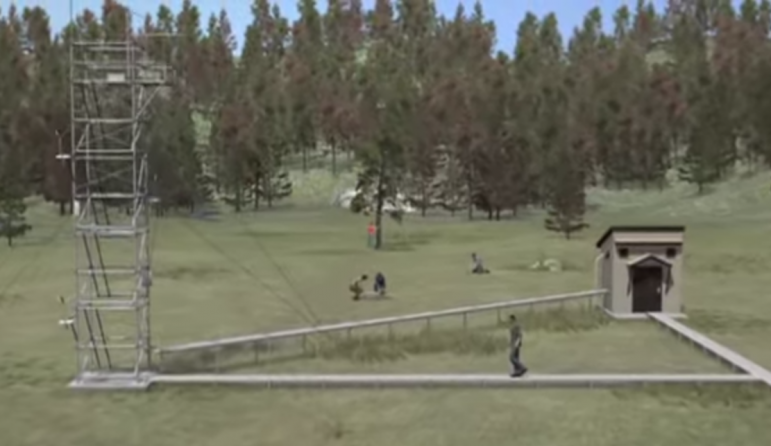
An image from a promotional video by the National Ecological Observatory Network shows what a sample monitoring station might look like. Yellowstone National Park has been selected as one of 60 proposed NEON sites.
A site in Yellowstone National Park has been proposed as one of 60 key monitoring stations in what is shaping up to be the largest long-term study of climate change in North America.
Funded by the National Science Foundation, the National Ecological Observatory Network (NEON) will gather a wide range of data at sites spread among 20 distinct eco-climatic domains across the United States. The project, budgeted at $60 million for the 2013 fiscal year, is designed to run for 30 years or longer in an effort to help researchers track the long-term effects of climate change across the entire continent.
Yellowstone officials are seeking public comments on a proposal to establish a number of automated NEON monitoring facilities on the Blacktail Plateau near Mammoth Hot Springs. The study will also look at how invasive species and land-use changes affect wide-scale ecology.
Yellowstone was chosen as a NEON site because “it is definitely one of the true wildland sites throughout the whole country,” said Dave Tazik, a NEON project scientist.
Under a proposal submitted by NEON planners, a 50-foot tower south of the Blacktail Plateau Road would use automated sensors to record air temperature, humidity, precipitation, air quality, soil chemistry and other data. A separate site nearby at Blacktail Creek would record stream flow, water chemistry, water temperature and more.
The two sites will give researchers a good idea of how a pristine, high-altitude Northern Rockies habitat that is mostly undisturbed by development is affected by climate change, Tazik said.
Like all 60 NEON monitoring locations, the Yellowstone tower and stream sites will see regular visits from field researchers gathering data or physical samples from plants, soil, water, air, microbes, insects, algae, aquatic species, fish, birds and even tufts of fur from small mammals.
After the data are analyzed and verified, they will be made publicly available via the NEON website.
“Our main mission is to push that data out for people to have access to so they can use it for research or any other purpose,” Tazik said.
Approximately 200 research projects are conducted in the park each year, but the NEON proposal is unique in its scope and duration, said Doug Madsen, with Yellowstone’s Planning Office.
“It’s rare to get a project this extensive, and it’s one that the park has put in a lot of time and effort on,” Madsen said. Planning for the site has been ongoing for more than three years.
Construction costs are estimated at roughly $1 million for each of the 60 NEON sites.
The Yellowstone NEON project would require installation of electric service, conduits, limited fencing, a small instrument building, and a meteorological platform tower which would extend about 20 feet above nearby trees, according to a statement released by the park’s public affairs office.
As many as 55 instrumented sampling plots would be established near the site. Equipment to gather aquatic data would be installed at a smaller site about 2.5 miles west of this core facility. Some of this infrastructure would likely be visible from a few locations along the Grand Loop Road.
Park planners said a number of sites that meet the project objectives will be considered and evaluated during the planning process.
Both the tower location and the aquatic site are in a grizzly bear management area, and access for researchers would be restricted during closures, just as for the public.
While data from NEON could prove helpful to Yellowstone researchers, the National Park Service has been gathering its own climate data for years.
Since 2000, the Greater Yellowstone Network has been one of dozens of projects run by the National Park Service Inventory and Monitoring Program, an initiative aimed at tracking natural resource data to aid in management decisions.
“The Mammoth weather station has 125 years of data—the longest set of weather records for the state of Wyoming—which is pretty amazing,” said Ann Rodman, resource information manager for Yellowstone.
“It’s really clear that the climate is changing, but the rate and magnitude of that change is not the same everywhere,” Rodman said in October during the Biennial Scientific Conference on the Greater Yellowstone Ecosystem in Mammoth.
“That’s why climate change science requires those valuable, long-term records,” she said.
Additional information on the Yellowstone NEON project and an electronic form to submit comments on the proposal are available on the National Park Service’s Planning, Environment and Public Comment (PEPC) Web site at http://parkplanning.nps.gov/ynpneon.
Comments may be also hand-delivered during normal business hours to the Mailroom in the park’s Administration Building in Mammoth Hot Springs, Wyoming, or mailed to: Compliance Office Attn: NEON Proposed Core Site Project, P.O. Box 168, Yellowstone National Park, WY, 82190. Comments must be received by midnight December 21, 2014.
NEON YELLOWSTONE NATIONAL PARK PRESENTATION for Internal Scoping Mtg 9 23 2014 (Text)

Will any of the NEON climate change facilities be visible from visitor sites, trails, roads, or facilities? I think that they should not.
Hi, Gloria.
Yes, as stated in the article above:
“Some of this infrastructure would likely be visible from a few locations along the Grand Loop Road.”